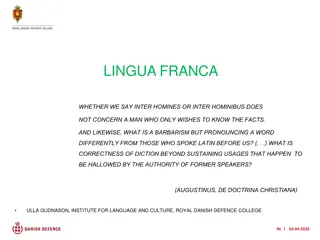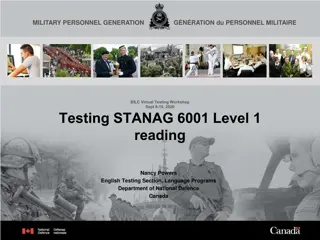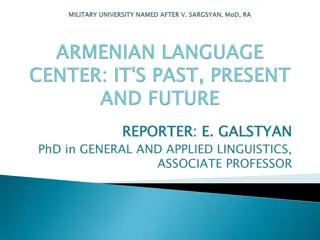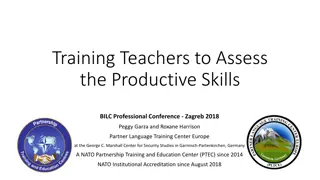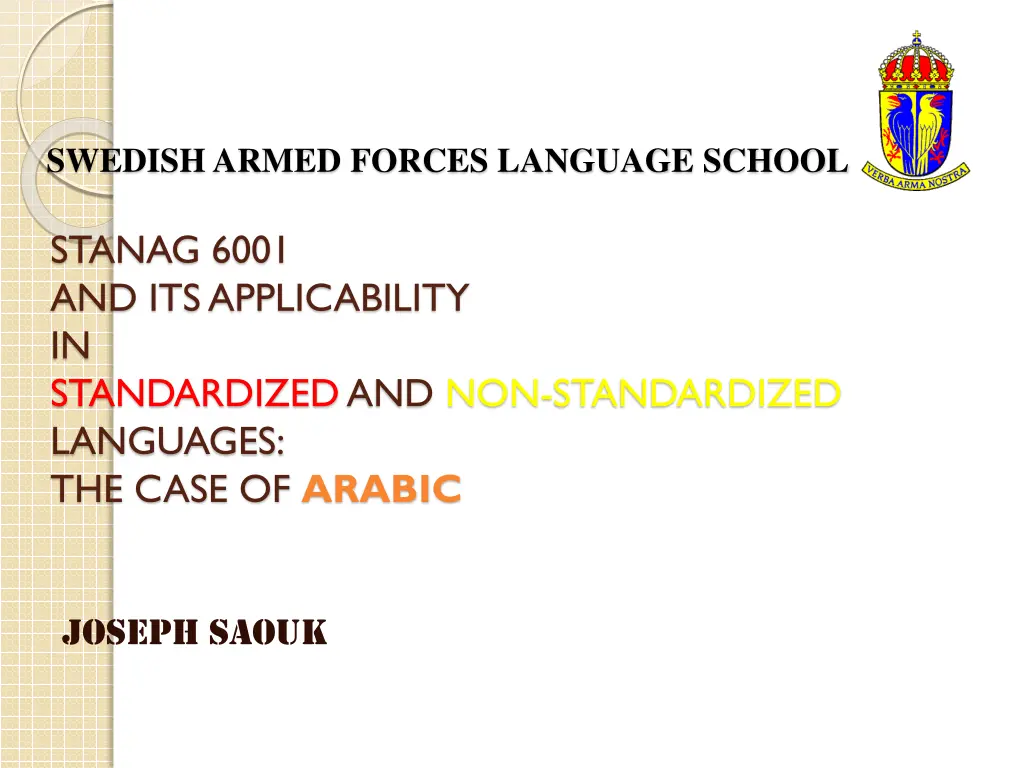
Arabic Language Varieties & STANAG 6001: Applicability in Military Settings
Exploring the use of Arabic in standardized and non-standardized forms within the framework of STANAG 6001, focusing on Modern Standard Arabic (MSA) and Dialectical Arabic (DA) variations. Understand the sociolinguistic concept of Arabic diglossia and its implications for linguistic training in military contexts.
Download Presentation

Please find below an Image/Link to download the presentation.
The content on the website is provided AS IS for your information and personal use only. It may not be sold, licensed, or shared on other websites without obtaining consent from the author. If you encounter any issues during the download, it is possible that the publisher has removed the file from their server.
You are allowed to download the files provided on this website for personal or commercial use, subject to the condition that they are used lawfully. All files are the property of their respective owners.
The content on the website is provided AS IS for your information and personal use only. It may not be sold, licensed, or shared on other websites without obtaining consent from the author.
E N D
Presentation Transcript
SWEDISH ARMED FORCES LANGUAGE SCHOOL STANAG 6001 AND ITS APPLICABILITY IN STANDARDIZEDAND NON-STANDARDIZED LANGUAGES: THE CASE OF ARABIC JOSEPH SAOUK
Arabic (and STANAG)? Non-standardized languages and STANAG?
International (?) languages: Interoperability Languages used by the UN (official website): Arabic English French Russian Spanish
Is Arabic a standardized or a non- standardized language? Which Arabic? (Modern) Standard Arabic (MSA)? Dialectal Arabic (DA)?
The Arabic diglossia First used for Arabic by William Mar ais 1930/31. Charles Ferguson 1959: (narrow) Diglossia : A sociolinguistic situation in which two genetically related, but very divergent , varieties of a language which are perceived as one language by the language community stand in a relationship of functional complementarity. (summarized by Mejdell 1999)
The Arabic diglossia Charles Ferguson1959: Diglossia : The high (H) variety is acquired through formal education and is used by (educated) members of the community for literary and formal occasions, while the low (L) variety is the naturally acquired vernacular of all the members of the community, and is used for informal, everyday communication. (summarized by Mejdell 1999)
DO WE HAVE (ONLY) A LEVEL RELATION BETWEEN THE ARABIC VARIETIES ? H H L L Is this as well the perception of the language community ?
Is STANAG applicable following to Arabic variety? 3+4+5 ?? H H L 1+2? L Variety = level (?)
The Arabic diglossia What about the linguistic difference/distance between the varieties H - L? The situation where dialects play the roll of speeches besides a high-variety exists not only within the Arabic-speaking region, however, nowhere else is the distance between the two forms as large as there. Fischer, W. & Jastrow, O. with contribution of: Behnstedt, P.; Grotzfeld, H.; Ingham, B.; Sabuni, A.; Schabert, P.; Singer, H.-R.; Tsotskhadze, L.; and Woidich, M. (1980) Handbuch der arabischen Dialekte.
Is the difference between Arabic diglossia and other cases one of (vertical) distance/grade? ? World Arabic H H H L L L
How is STANAG supposed to be applied to Arabic? IS THE VERNACULAR H UNUSABLE (NON- H EXISTING) ON L HIGHER LEVELS? L
The Arabic diglossia How to understand: COMPLEMENTARITY? GENETICAL RELATION? SAME LANGUAGE ?
MSAs domains: if someone needs to give a lecture at a university, or a sermon in a mosque, he is expected to use Standard Arabic, a variety different at all levels from the local vernacular, and felt to be so different from the vernacular that it is taught in schools in the way foreign languages are taught in English speaking societies. Hudson: Sociolinguistics s. 54. Cambridge University Press 1980.
Perception vis-a-vis feeling of the language community Ferguson Hudson (H and L) varieties of a language which are perceived as one language by the language community (SA) a variety felt to be so different from the vernacular that it is taught in schools in the way foreign languages are taught in English speaking societies. Feeling? Belief?
ARAB HUMAN DEVELOPMENT REPORTS
Arabic diglossic case: some problematic aspects The teaching of Arabic is also undergoing a severe crisis in terms of both methodology and curricula. The most apparent aspect of this crisis is the growing neglect of the functional aspects of (Arabic) language use AHDR 2003 (p. 26).
Appropriateness of teaching MSA The situation of Arabic language teaching cannot be separated from that of classical Arabic in general, which has in effect ceased to be a spoken language. It is only the language of reading and writing; the formal language of intellectuals and academics, often used to display knowledge in lectures. Classical Arabic is not the language of cordial, spontaneous expression, emotions, daily encounters and ordinary communication. It is not a vehicle for discovering one s innerself or outer surroundings. (AHDR 2003:26)
Standardization of Modern Standard Arabic (MSA) (Versteegh, K. The Arabic Language ) Standardization of Arabic In modern time. [F]ounded with explicit references to the example of the Acad mie Fran aise 1919: Syria: The Academy of the Arabic Language in Damascus 1932: Egypt: the Academy of Cairo 1947: Iraq: the Academy of Iraq 1976: Jordan: the Academy of Jordan .
Goals and purposes of the academies (Versteegh K. The Arabic Language ) To guard the integrity of the Arabic language and preserve it from dialectal and foreign influence. To adapt the Arabic language to the needs of modern times. Quality of the educational systems Preservation of the cultural heritage
Domains of each variety: MSA DA Formal: every written text! Text books Teaching books Newspapers Personal letters* Ad:s Culture: song, theater et c Everyday use: generally every oral contact. Not in mosques/sermons/ Not in univ. lectures Not in some tv- interviews. Not in written*
The Arabic diglossia What is Arabic? (Prof. Jan Rets : vad r arabiska? 2001). Arabiyya c-a modern dialects . Linguistic distance like that between Swedish and Icelandic OR Latin and Italian (?)
Varieties and levels? MSA 5 4 3 2 1 DA 5 4 3 2 1 a variety different at all levels from the local vernacular ? Maltese!
The Arabic diglossia: Levels or varieties/languages? ? ? H H L L
The Arabic diglossia Monoloingual register variation? Bilingual code interaction?
Arabic diglossic case (there may be very great differences between one dialect of Arabic and another, to the point of mutural incomprehensibility), with little variation between the most educated and the least educated speakers . Hudson, R. A. Sociolinguistics (p. 54).
Examples on functional level (2) English: what do you want? Arabic: MSA: maatha toreed? EA: aewiz eh? LA: shoo biddak? IA: shetreed? GA: (ee-)shtebee?
Examples on functional level (2) English: where are you going? Arabic: MSA: ila ayna tadh-hab? EA: raayiH feen? LA: laween raayeH? IA: wein raayeH?
The Arabic diglossia GA IA LA EA
References in STANAG to the proficiency of native speaker/listener Listening: 2 Can reliably understand face-to-face speech in a standard dialect, delivered at a normal rate with some repetition and rewording, by a native speaker not used to speaking with non-natives. Listening: 3 Can follow accurately the essentials of conversations among educated native speakers, lectures on general subjects
References in STANAG to the proficiency of native speaker/listener Listening: 4 Readily understands utterances made in the media and in convesations among native speakers both globally and in detail, generally comprehends regionalisms and dialects. Listening 5 Comprehension equivalent to that of the well-educated native listener. Able to fully understand all forms and styles of speech intelligible to the well-educated native listener
References in STANAG to the proficiency of native speaker/listener Speaking: 2 Can interact with native speakers not used to to speaking with non-natives, although natives may have to adjust to some limitations. Speaking: 3 Can use the language clearly and relatively naturally to elaborate on conepts freely and ake ideas easily understandable to native speakers.
References in STANAG to the proficiency of native speaker/listener Speaking: 4 Can set the tone of both professional and non-professional verbal exchanges with a wide variety of native speakers. Speaking: 5 uses the language with great flexibility so that all speech, including vocabulary, idioms, colloquialisms, and cultural references, is accepted as native by well-educated native listeners
References in STANAG to the proficiency of native reader Reading: 4 Reading speed is similar to that of a native reader. Reading: 5 Able to fully comprehend all forms and styles of the written language understood by the well- educated native reader
References in STANAG to the proficiency of native writer/reader Writing: 3 Errors are occasional, do not interfere with comprehension, and rarely disturb the native reader. Writing: 5 Writing proficiency is functionally equivalent to that of a well- educated native writer
Examples on higher levels Gunvor Mejdell: Switching, Mixing: Code Interaction in Spoken Arabic . EA is the dominant language in diglossic code interaction though not necessarily the underlying, or matrix , code of all speech production.
Transcription signs SA: Standard Arabic (in bold) EA: Egyptian Arabic (in italic) N: Neutral (in plain)
Examples on Arabic language use somebody else than the others write about, and consequently an artistic expression different from that of the others .
Dominant language: The code which supplies the grammatical morphemes is the matrix. (Myers-Scotton)
Sociolinguistic aspects in code- mixing FS: insisting on his cultural role, YI: insists on his identity as left-wing intellectual Model of language use Yet modern and secular (not religious azhari) Not pompous (not orthoepic: with case endings) Allegiance to the common people (non- snobbish) Leaving enough traces of SA (cultured man).
Arabic diglossic case The Arabic diglossic case is socio-linguistically to be situated somewhere between bilingual code interaction and monolingual register/style variation. Mejdell (p. 225.)
The Arabic diglossia Monoloingual register variation Bilingual code interaction Arabic diglossia H H DA MSA L L MSA DA
The Arabic diglossia Ferguson s prediction?
References Farjani, N. (Ed.) (2003): Arab Human Development Report: Building a Knowledge Society. United Nations. Ferguson, C. A. (1959): Diglossia. Word 15, 325-340. Fischer, W. & Jastrow, O. with contribution of: Behnstedt, P.; Grotzfeld, H.; Ingham, B.; Sabuni, A.; Schabert, P.; Singer, H.-R.; Tsotskhadze, L.; and Woidich, M. (1980) Handbuch der arabischen Dialekte. Hudson, R. A. (1980): Sociolinguistics. Cambridge University Press. Mar ais W. 1930/31: La diglossie arabe. L enseignement Public Revue p dagogique CIV, 12, 401-409 and CV, 20-39 and 120-133. Mejdell, G. (1999): Switching, mixing Code interaction in spoken Arabic. In Brendemoen Bernt, Lanza Elizabeth and Ryen Else (Eds.): Language Encounters Space (pp. 225-241). Oslo, Novus Press. Myers-Scotton, C. (1993): Social Motivations for Codeswitching (Oxford studies in Lnaguage Contact). Oxford: Clarendon Press. Versteegh, K. (1997): The Arabic Language. Edinburgh: Edinburgh University Press. Across Time and


